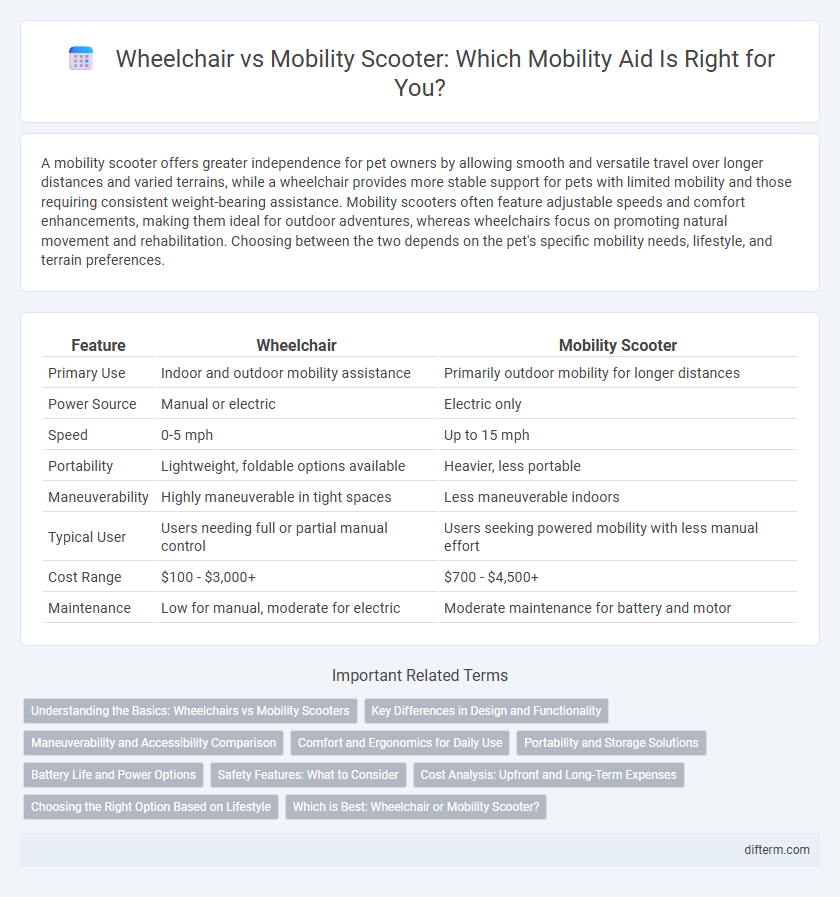A mobility scooter offers greater independence for pet owners by allowing smooth and versatile travel over longer distances and varied terrains, while a wheelchair provides more stable support for pets with limited mobility and those requiring consistent weight-bearing assistance. Mobility scooters often feature adjustable speeds and comfort enhancements, making them ideal for outdoor adventures, whereas wheelchairs focus on promoting natural movement and rehabilitation. Choosing between the two depends on the pet's specific mobility needs, lifestyle, and terrain preferences.
Table of Comparison
| Feature | Wheelchair | Mobility Scooter |
|---|---|---|
| Primary Use | Indoor and outdoor mobility assistance | Primarily outdoor mobility for longer distances |
| Power Source | Manual or electric | Electric only |
| Speed | 0-5 mph | Up to 15 mph |
| Portability | Lightweight, foldable options available | Heavier, less portable |
| Maneuverability | Highly maneuverable in tight spaces | Less maneuverable indoors |
| Typical User | Users needing full or partial manual control | Users seeking powered mobility with less manual effort |
| Cost Range | $100 - $3,000+ | $700 - $4,500+ |
| Maintenance | Low for manual, moderate for electric | Moderate maintenance for battery and motor |
Understanding the Basics: Wheelchairs vs Mobility Scooters
Wheelchairs provide manual or powered assistance for individuals with limited mobility, allowing for greater control in tight spaces and indoor use. Mobility scooters offer enhanced speed and comfort for longer distances, often featuring larger wheels and extended battery life for outdoor travel. Choosing between the two depends on user needs such as terrain, range, and independence level.
Key Differences in Design and Functionality
Wheelchairs feature a lightweight frame with manual or electric controls designed for maneuverability in tight spaces, while mobility scooters typically have a sturdier build with larger seats and enhanced suspension for outdoor use. Wheelchairs prioritize user-driven propulsion or assisted movement, making them suitable for both indoor and short-distance travel, whereas mobility scooters offer motorized operation with higher speed and range, ideal for longer distances on varied terrains. The design differences reflect distinct functional purposes: wheelchairs emphasize portability and precision, while scooters focus on comfort and extended mobility.
Maneuverability and Accessibility Comparison
Wheelchairs offer superior maneuverability in tight indoor spaces due to their compact design and ability to pivot easily, making them ideal for navigating narrow doorways and crowded areas. Mobility scooters provide enhanced accessibility for longer distances and outdoor terrain, featuring larger wheels and stable platforms but require more space to turn and may struggle in confined settings. Choosing between the two depends on specific user needs, including the environment and distance typically traveled.
Comfort and Ergonomics for Daily Use
Wheelchairs offer tailored ergonomic support with adjustable seating and posture control, enhancing comfort during prolonged use and reducing pressure sores. Mobility scooters provide a more relaxed, scooter-style seating position with suspension systems designed for outdoor mobility, prioritizing ease of operation over fine ergonomic adjustment. For daily use, selecting between a wheelchair and a mobility scooter depends on individual needs for posture support, maneuverability, and duration of use to ensure optimal comfort and reduced strain.
Portability and Storage Solutions
Wheelchairs prioritize compact foldability, enabling easier portability and storage in small vehicle trunks or closets, while mobility scooters often require disassembly into multiple pieces for transport. Lightweight manual wheelchairs typically weigh between 15-30 pounds, offering enhanced maneuverability compared to heavier scooters, which can exceed 80 pounds. Storage solutions for mobility scooters often involve dedicated racks or lifts due to their bulk, whereas foldable wheelchairs benefit from versatile storage options compatible with limited spaces.
Battery Life and Power Options
Wheelchairs typically offer shorter battery life compared to mobility scooters due to their compact batteries designed for portability and indoor use. Mobility scooters feature larger, more powerful batteries that support longer travel distances and higher speeds, ideal for outdoor mobility. Power options in wheelchairs often include removable batteries for easy charging, while mobility scooters frequently provide advanced battery management systems to optimize performance and extend battery lifespan.
Safety Features: What to Consider
Wheelchairs typically offer greater stability with low center-of-gravity designs and enhanced braking systems, suitable for indoor and uneven terrains. Mobility scooters prioritize speed control, anti-tip mechanisms, and robust lighting for outdoor use in various weather conditions. Evaluating features such as maneuverability, terrain adaptability, and emergency stop functions is crucial for ensuring user safety in both devices.
Cost Analysis: Upfront and Long-Term Expenses
Wheelchairs generally have a lower upfront cost, often ranging from $300 to $1,500, while mobility scooters typically start at $800 and can exceed $3,000. Maintenance expenses for wheelchairs are usually minimal, but mobility scooters incur higher long-term costs due to battery replacements, motor repairs, and regular servicing. Evaluating total cost of ownership requires considering purchase price, ongoing maintenance, and potential insurance or accessory costs.
Choosing the Right Option Based on Lifestyle
Selecting between a wheelchair and a mobility scooter depends on individual mobility needs and daily activities. Wheelchairs offer greater maneuverability in tight indoor spaces and are ideal for users requiring assistance with walking. Mobility scooters provide enhanced speed and range, making them suitable for outdoor use and longer distances, supporting users with moderate mobility challenges seeking convenience and independence.
Which is Best: Wheelchair or Mobility Scooter?
Choosing between a wheelchair and a mobility scooter depends on individual mobility needs, terrain, and activity level. Wheelchairs offer greater control and maneuverability in tight indoor spaces, while mobility scooters provide enhanced speed and ease on outdoor or uneven surfaces. Assessing factors like user strength, travel distance, and storage convenience helps determine the best mobility solution.
wheelchair vs mobility scooter Infographic

 difterm.com
difterm.com